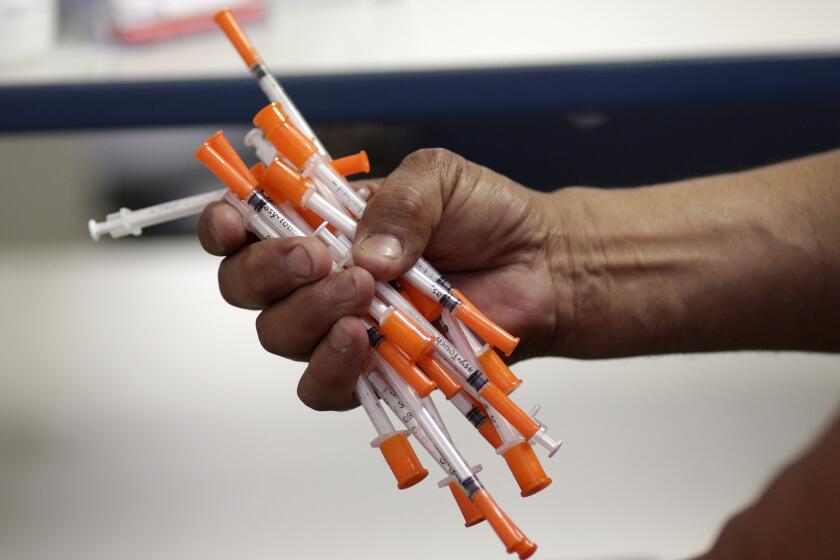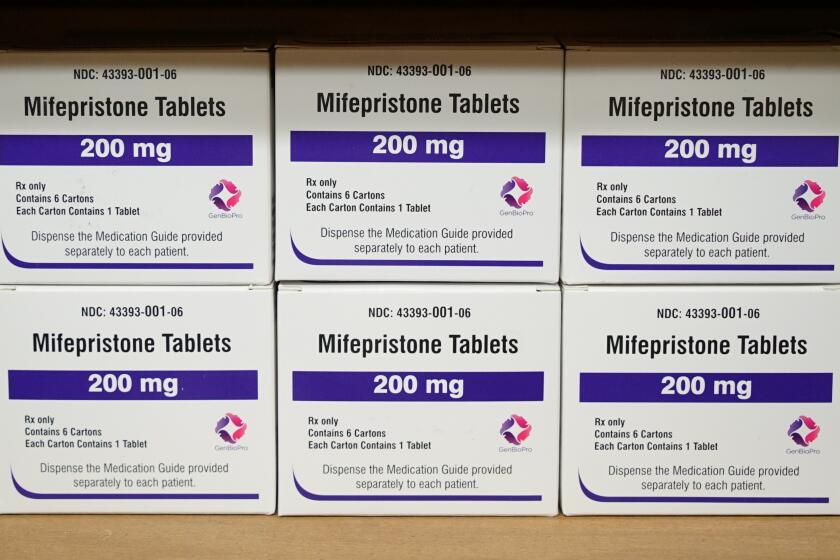Data May Renew Debate Over Silicone Implants
Will the silicone gel breast implant survive?
It looks possible, says a researcher charged with analyzing the data from the government-authorized study on the implants, which have been under a moratorium since 1992.
“There is some optimism, with all the scientific data available, that the Food and Drug Administration will reconsider the ban,” says Dr. Garry Brody, a professor of plastic surgery at USC who has been hired by the Mentor Corp. of Santa Barbara to analyze its study data in preparation for submitting it to the FDA.
Brody says that his analysis will not be completed until later this summer and that the FDA has indicated that an additional 18-month study might be required. But, so far, the data seem to clear the implants from the host of serious complications that thousands of women claim to suffer, he says.
Other observers of the long-simmering controversy caution that it is too early to predict the future of silicone gel implants. Nevertheless, only a few years ago it seemed entirely possible that the implants would join the dubious list of products--the Dalkon shield, for one--forever banned from the marketplace for their inherent hazards.
“There is some possibility the moratorium will be lifted. But the FDA is still asking for more information and more data. And I don’t think we should consider telling people that they should wait for silicone gel implants because they will be available next year. I don’t think that’s realistic,” says Dr. Ronald Iverson, president of the American Society of Plastic and Reconstructive Surgeons.
The upcoming analysis of Mentor data follows other signs that an end to the debate may be in sight. A top FDA official recently said that “it’s time to look at” whether enough scientific information is available to allow women to make an informed decision.
More than a dozen large studies have failed to show a link between the implants and serious diseases affecting the immune system and connective tissue.
*
Meanwhile, a large study by the Mayo Clinic recently delineated the complication rate of the implants, including the risks of capsular contraction (tissue growth around the implants that causes hardening and deformities) and the risk of rupture. The new data are considered very valuable because they more precisely describe the complication rate in women undergoing breast augmentation or reconstruction.
The FDA will not comment on its timetable for reviewing the implants, but the Mentor Corp. data is clearly important. The company was the only one cleared by the FDA to continue manufacturing silicone gel implants as part of a clinical research study.
In 1992, then-FDA Commissioner David Kessler issued a moratorium on the implants based on thousands of consumer complaints, pending further scientific review. The Mentor Corp. was allowed to continue to manufacture the implants for women who needed reconstructive surgery--as opposed to those who wanted them for purely cosmetic reasons--as part of a safety study.
As of this month, 17,000 patients were enrolled in the study, says Gary Mistlin, vice president of finance for Mentor Corp. The company has also completed its laboratory and animal tests.
“We’ve done an immense amount of work in the lab. And we’ve gotten three years of history [among implant recipients in the study]. The FDA has asked us to compile that data and give it to them sometime this fall,” Mistlin says. “We certainly believe the product should be more widely available. And this is a good first step.”
Besides the collection of three years of data, Mistlin says the FDA’s apparent interest in reviewing the moratorium stems from a citizens’ petition filed last fall by the Y-ME National Breast Cancer Organization along with eight other prominent groups, including the American Society of Clinical Oncology and the National Alliance of Breast Cancer Organizations. The petition strongly urged the FDA to ease restrictions on silicone implants.
Not only does the majority of scientific evidence dispel a connection between implants and disease, the petition states, but: “Continuing the current restrictions on silicone implants denies informed patients of a choice in therapeutic breast reconstruction.”
Although the silicone implants are available through the clinical trials, many breast cancer patients have had difficulty gaining access to the study. Only a small number of surgeons is actively participating in the trial, according to Y-ME’s petition, and many insurance companies have refused to cover the implants. According to the petition, only 12,000 women received silicone implants in the first three years of the moratorium from a pool of about 60,000 women who were likely candidates for implants.
Women who seek breast augmentation are also dismayed by the inability to obtain silicone implants, says Dr. Garth Fisher, a Beverly Hills plastic surgeon who is participating in the Mentor study.
“The people who can’t get into the [Mentor] study are frustrated,” he says. “I think it’s unfortunate that it was taken off the market. All the studies have pretty much shown that silicone can’t be linked to these illnesses conclusively.”
*
Besides the lack of scientific evidence implicating silicone implants, the products may survive the safety controversy simply because no other existing or experimental implant shows great promise as a satisfactory replacement.
“All of us plastic surgeons are looking for the perfect implant,” Fisher says. “It’s an elusive search. Right now there are certain benefits that silicone provides that others don’t.”
And that will probably continue to be the case, Brody says.
“I don’t know whether one could restore confidence with silicone 100% with women because of all the publicity it has had. But there is nothing on the horizon with all the properties of silicone. It has become apparent that the best results occur with a silicone gel implant,” he says.
Studies on soy oil are still ongoing. But, “The best guess is that it will have many of the same characteristics as saline,” says Brody, who is conducting some of the research on soy oil.
Women can still opt for a saline-filled implant, but it is not considered as aesthetically pleasing as the silicone gel, which offers numerous advantages.
“Gel tends to mimic the flow of fat in normal breast tissue,” Brody says. “And silicone is the only filler that, if the implant breaks, won’t deflate. Of course, you can have a nice result with saline and a bad result with gel. But, overall, the best result is with gel for reconstruction. In the pre-moratorium era, 80% of implants were gels.”
According to Iverson, many patients are satisfied with saline implants, and he suggests that silicone gel implants would have a limited market if they became available without restrictions.
“A lot of plastic surgeons say they’d never use gels again. Others are pushing to get the gels back out. I’d say [plastic surgeons] are split about 50-50,” he says.
Women, too, are divided on the issue of whether it’s time to pronounce silicone gel breast implants as safe enough. Those who say they have become ill due to the implants continue to fight for an outright ban on the product.
One activist in Houston recently filed a petition with the FDA asking that the Mentor study be halted. “We’re seeing far too much illness,” says Marlene Keeling. “And the rupture rate is far too high.”
She disagrees that the Mentor data will resolve the question of safety since it will follow women for only a limited time.
“The problem is that there is a latency period with the illness. Most of the data shows a latency period of seven years. They are only going to follow these women for five years,” she says.
Keeling acknowledges that government, scientific and--to some extent--public sentiment may be shifting toward absolving the implants.
“We are fighting against the tide. But we feel it’s because of misinformation. We are underfinanced. We are sick women. We are fighting large manufacturers and plastic surgeons’ groups who have unlimited funds for public relations.”



